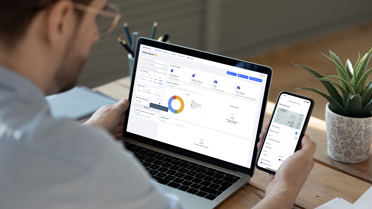What is an electronic invoice, and how will it impact French businesses?
French law defines an electronic invoice, or e-invoice, as an invoice issued, transmitted, and received in a digital format. It must include a minimum set of data in a structured form, such as the seller's and buyer's details, invoice number, date, and amount. This means invoices are no longer paper or basic PDFs but digital documents sent electronically for payment.
Standard structured data formats in France include UBL (Universal Business Language), CII (Cross-Industry Invoice), and Factur-X (which combines a PDF and an XML file). These formats ensure that e-invoices provide purely semantic data, enabling direct importation of all the information into other software systems, unlike image or paper invoices. The core of an e-invoice is an XML format, which is not readable on its own but is perfect for automated processing.
Advantages of electronic invoicing
The adoption of e-invoicing not only offers economic benefits but also contributes to a greener environment. By reducing paper consumption, e-invoicing helps conserve resources and decrease CO2 emissions from mailing invoices. This environmental impact can motivate businesses to adopt e-invoicing as a sustainable business practice.
Electronic invoices offer a streamlined and efficient process. They are quicker to create and manage than paper invoices. With the help of software, data extraction and processing within an invoice can be automated, eliminating manual tasks and accelerating business processes. Pre-established accounts within the e-invoicing framework can significantly reduce data entry errors, and checks for duplicates or validity are automated. This can lead to a shorter time between invoice issuance and payment, providing relief during the transition to e-invoicing.
E-invoicing can also help reduce potential disputes and VAT fraud.
The future of e-invoicing in France
The current situation
Since January 1, 2020, French companies must, by law, send e-invoices to government agencies through the Chorus Pro platform. However, inter-company transactions are not yet subject to this obligation, and e-invoice use in this context remains uncommon. This is set to change in the coming years, with the government firmly supporting and pushing for wider adoption of e-invoicing to streamline business operations and reduce administrative burdens. This government backing should reassure businesses about the necessity and benefits of e-invoicing.
Key dates and when the obligation comes into force
In 2024, e-invoicing in France will take a significant leap forward. All French companies subject to VAT must receive electronic invoices in Factur-X, UBL, or CII formats. JPEG, PDF, and PNG formats will no longer be accepted.
This obligation, originally scheduled for July 1, 2024, as per the December 30, 2022 finance law for 2023 and the September 15, 2021 ordinance, was postponed by the government in a press release dated July 28, 2023. A new date is not yet available.
The goal is to boost the efficiency of commercial exchanges and promote business digitalization.
Companies will phase in the obligation to issue e-invoices based on their size.
- Large companies: July 1, 2024 (original deadline)
- Medium-sized companies: January 1, 2025
- Micro, small and medium-sized enterprises (SMEs): January 1, 2026
The government announced these initial rollout dates; new deadlines may be forthcoming.
Impact on businesses
French businesses, especially large companies, should prepare to receive and issue e-invoices by the new government deadline (to be announced in the Finance Act for 2024). Failure to comply with these regulations could result in penalties or legal issues, making it crucial for businesses to act promptly. By taking proactive steps to prepare for e-invoicing, businesses cannot only avoid potential penalties but also position themselves as early adopters of a more efficient and sustainable business practice.
To prepare for e-invoicing, businesses must choose a government-approved platform (such as the Public Billing Portal or a private dematerialization platform) to receive and send e-invoices. This involves familiarizing themselves with the relevant tools and standards and setting up systems to generate, send securely, and archive e-invoices in compliance with regulations.
As with any invoice, e-invoices must be stored and accessible for the minimum legal period.
Expensya and electronic invoices
Expensya helps companies automate expense claim and business payment management, from data entry to accounting and validation. Our intelligent, self-learning SaaS software simplifies expense claim processing and management, drastically reducing or even eliminating data entry errors. With Expensya, companies can also manage their e-invoicing process, ensuring compliance with regulations and streamlining their financial operations.

Expensya, as a leading expense management software, is already working towards integrating with the Public Billing Portal (PPF) or private dematerialization platform (PDP) partners. Once the government deadline has passed and companies start receiving or issuing this type of invoice, Expensya can read and process them, making the transition to e-invoicing seamless and efficient.
Paper invoices, or ones you get by email, can be sent straight to Expensya. They'll automatically capture and add them to your account, whether the invoice is in the email body or as an attachment.
Ready to learn more? Ask one of our team experts.





